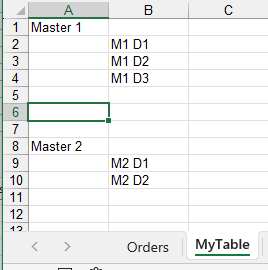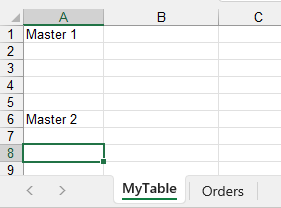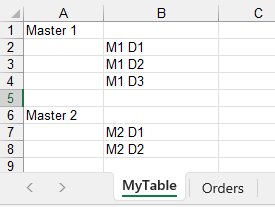<#include(..)> causes AV if placed after or in the same sheet where there's a implicit relationship range/band name defined.
How to reproduce:
1-Take Flexcel Include demo project.
2-Add System.Generics.Collections to UMainForm.pas uses clause.
3-Replace RunReport method by:
type
TMyDetail = class
private
FName : string;
public
property Name : string read FName write FName;
class function New(Name : string) : TMyDetail;
end;
TMyMaster = class
private
FTitle : string;
FDetails : TObjectList<TMyDetail>;
public
constructor Create;
destructor Destroy; override;
function AddDetail(Detail : TMyDetail) : TMyMaster;
class function New(Title : string) : TMyMaster;
property Title : string read FTitle write FTitle;
property Details : TObjectList<TMyDetail> read FDetails;
end;
TMyTable = class(TObjectList<TMyMaster>)
public
class function New : TMyTable;
end;
{ TMyTable }
class function TMyTable.New: TMyTable;
begin
Result := TMyTable.Create(True);
end;
{ TMyMaster }
function TMyMaster.AddDetail(Detail: TMyDetail): TMyMaster;
begin
Result := Self;
Details.Add(Detail);
end;
constructor TMyMaster.Create;
begin
FDetails := TObjectList<TMyDetail>.Create(True);
end;
destructor TMyMaster.Destroy;
begin
FDetails.Free;
inherited;
end;
class function TMyMaster.New(Title: string): TMyMaster;
begin
Result := TMyMaster.Create;
Result.Title := Title;
end;
{ TMyDetail }
class function TMyDetail.New(Name: string): TMyDetail;
begin
Result := TMyDetail.Create;
Result.Name := Name;
end;
procedure TMainForm.RunReport;
var
Report: TFlexCelReport;
MyTable : TMyTable;
begin
if not SaveDialog.Execute then exit;
Report := TFlexCelReport.Create(true);
MyTable := TMyTable.Create;
MyTable.Add(
TMyMaster.New('Master 1')
.AddDetail(TMyDetail.New('M1 D1'))
.AddDetail(TMyDetail.New('M1 D2'))
.AddDetail(TMyDetail.New('M1 D3'))
);
MyTable.Add(
TMyMaster.New('Master 2')
.AddDetail(TMyDetail.New('M2 D1'))
.AddDetail(TMyDetail.New('M2 D2'))
);
try
Report.AddTable<TMyMaster>('MyTable', MyTable);
Report.AddTable('Order Details', DemoTables.OrderDetails);
Report.SetValue('ReportCaption', 'ORDERS');
Report.SetValue('Date', Now);
Report.Run(
TPath.Combine(GetDataPath, 'Includes.template.xls'),
SaveDialog.FileName);
finally
MyTable.Free;
Report.Free;
end;
if MessageDlg('Do you want to open the generated file?', mtConfirmation, [mbYes, mbNo], 0) = mrYes then
begin
ShellExecute(0, 'open', PCHAR(SaveDialog.FileName), nil, nil, SW_SHOWNORMAL);
end;
end;
4-In includes.template.xls, add a "MyTable" sheet after Orders sheet.
5-add tags to generate MyTable content at result file, as:

6 - Create a range name for MyTable and it's details, as
![]()
7-Run the program. It's all right:
8-Back to the template, move MyTable sheet, so that now it's placed before Orders sheet.

Save it.
9-Click "Go!" again.
And you'll get:

ps: the problem is when the detail implicit relationship is active.
If you delete Details range name and MyTable cell B2 (<#Details.Name), the report will run fine, even with MyTable sheet being the first sheet.
Could you please check?
Thanks.




